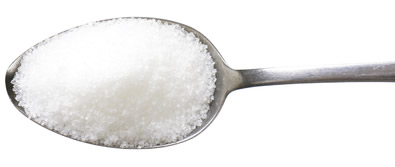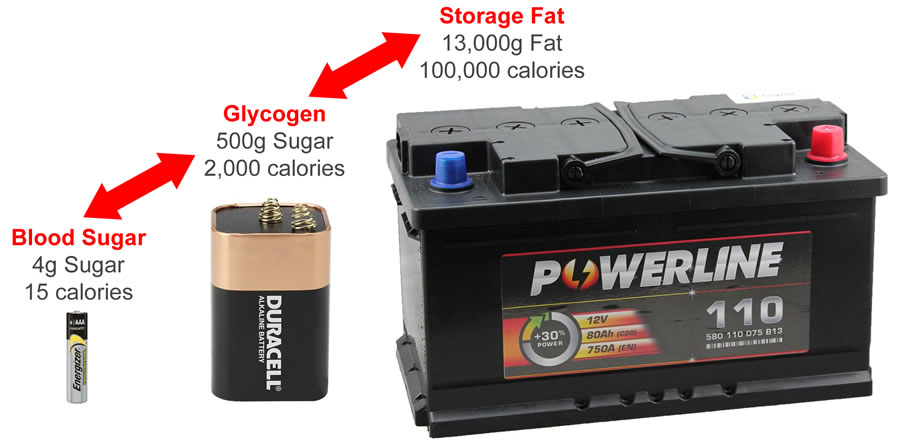Have you every thought how much sugar is in your blood? Glucose is the energy that our muscles and cells need, you would think that there would be bags of it racing through our veins.
- An average person has 0.4- 0.7g/pint (or 1g/pint after a sugary meal).
- An average adult has around 10 pints of blood in their body, so the total glucose in the bloodstream is 5-6 grams (or just one heaped teaspoon!).
 Our body does an incredible job at constantly keeping the "toxic sugar" to such a low and constant level. It does this by producing insulin hormone in the pancreas. Once the dominant insulin is in the blood, it pushes glucose, amino acids and blood fats into the cells of the body. The body breaks down or converts most carbohydrates into glucose (the simplest and smallest sugar C6H12O6). Glucose is absorbed into the bloodstream, and either:-
Our body does an incredible job at constantly keeping the "toxic sugar" to such a low and constant level. It does this by producing insulin hormone in the pancreas. Once the dominant insulin is in the blood, it pushes glucose, amino acids and blood fats into the cells of the body. The body breaks down or converts most carbohydrates into glucose (the simplest and smallest sugar C6H12O6). Glucose is absorbed into the bloodstream, and either:-
- Gets used as energy within the cells (with the help of insulin). When your body senses a sugary hit coming, it releases insulin.
or - Gets stored in your liver and muscles as a substance called glycogen (glycogenesis is where several glucose molecules are welded together into glycogen). Your liver and muscles are essentially a "battery" for your body, because when your cells need energy, the glycogen is broken down into glucose again.

So how do people get fat by eating sugars?
Your body can hold a tiny amount of glucose in the bloodstream and your liver and muscles can hold a lot more as glycogen. Stored glycogen can provides around 1700 calories or 500 grams of glycogen, which is enough for an hour of exercise.
So when your blood, liver and muscles can't hold any more glucose/glycogen your body will start to metabolise the glycogen into fatty acids and stored fat as triglycerides within adipose tissue. Adipose tissue is made up of collections of “adipocytes” or fat cells.
So the quickest way to gain fat is to be inactive AND keep your body topped up with sugary foods and simple carbs all day long.... you will never deplete your glycogen stores and start tapping into fat reserves.
How do you loose fat?
The reverse happens when glycogen levels are depleted. The body will start to "burn" fatty acids and fats as an energy source. This happens when your adipocytes (fat cells) receive a signal to kick into action, it begins a process called Lipolysis. Lipolysis causes your fat cells to separate into free fatty acids and glycerol and release them into your blood stream. Glycerol is easily converted into glucose and glycogen for energy (or oxidised via another cycle). The fatty acids are turned into energy.
The fatty acid chains are broken apart through oxidation into Acetyl-CoA which can enter the Citric acid cycle along with oxygen (it is a series of chemical reactions used by all aerobic organisms to release stored energy through the oxidation of acetyl-CoA into carbon dioxide and chemical energy) to create Adenosine triphosphate (ATP). Glucose can go through the Citric Acid Cycle without oxygen, but it’s a far more efficient process to create energy with oxygen whether it be from fat or proteins.
Your body uses fat to generate as much as 60% of the energy when at rest. When you get active, it tends to rely more on glycogen stored in the muscles and liver, but over time your fat will gradually take over as your glycogen stores are depleted. Your body will always replenish glycogen storage from fat storage. Plus your body will be constantly insulin spiking which will make you insulin dependent (pre-diabetic).
So the quickest way to lose fat is to be active AND not depend upon sugary foods and simple carbs as your main calories. If you implement intermittent fasting and HIIT exercises you will pressurise your glycogen storage and start tapping into fat reserves.
